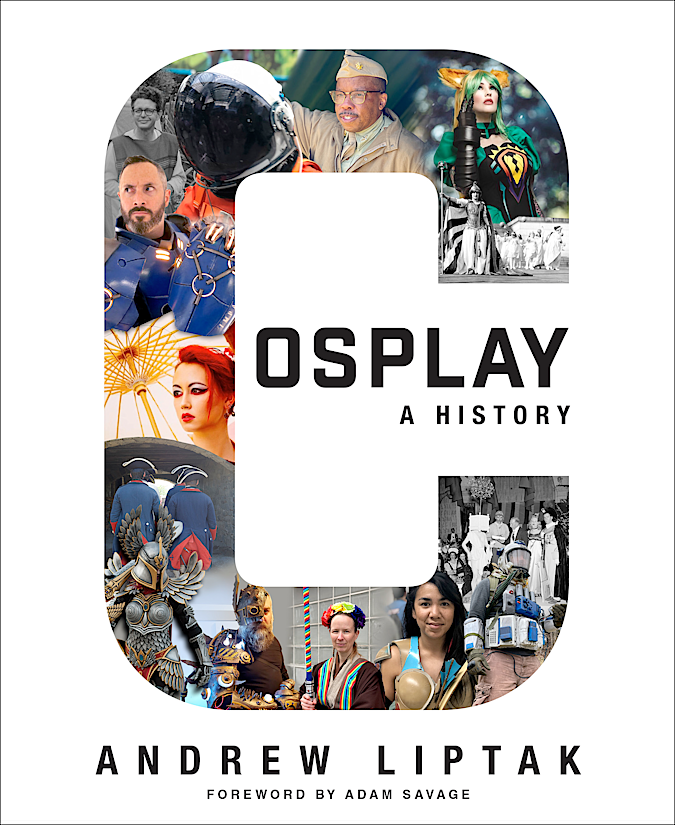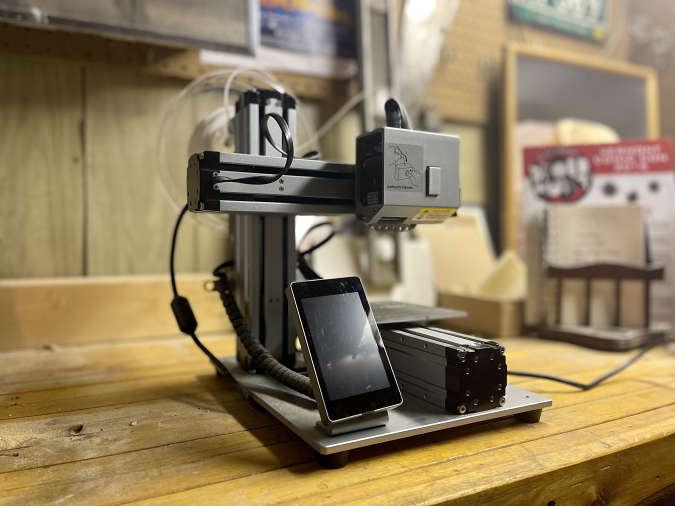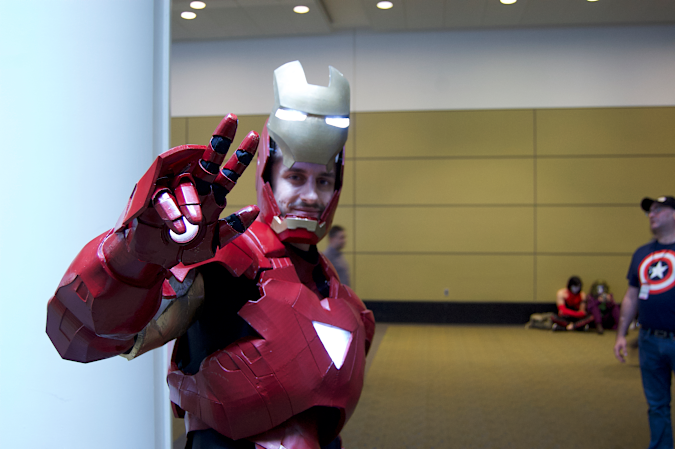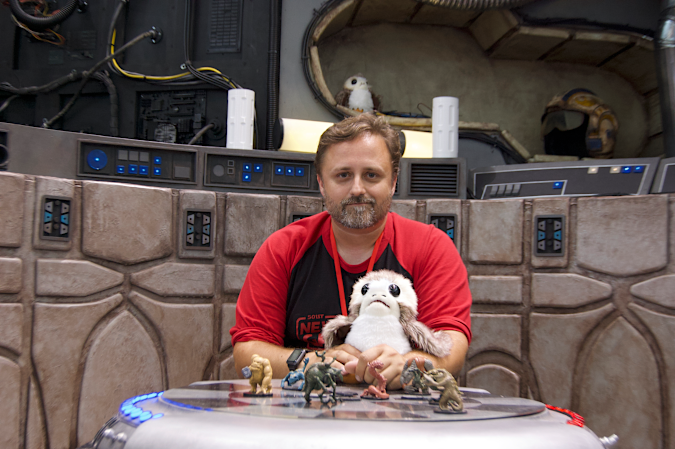Additive manufacturing is one of the most important technological advances of the 21st century. It’s revolutionized the way we build everything from airplanes and wind turbines to medical implants and nano-machinery — not to mention the tidal wave of creativity unleashed once the tech made its way into the maker community. In Cosplay: A History, veteran cosplayer and 501st Legion member, Andrew Liptak explores the theatrical origins of the craft and its evolution from costuming enthusiasm to full-fledged fandom. Liptak also looks at how advances in technology have impacted the cosplay community — whether that’s the internet forums and social media platforms they use to connect, the phones and cameras they use to publicize their works, and, in the excerpt below, the 3D printers used to create costume components.

Simon and Schuster
Excerpted from Cosplay: A History – The Builders, Fans, and Makers Who Bring Your Favorite Stories to Life by Andrew Liptak, published by Simon & Schuster. © 2022 by Andrew Liptak.
In the summer of 2017, I picked up a Nintendo Switch and began playing the latest installment of Nintendo’s The Legend of Zelda series, Breath of the Wild. My son, Bram, and I hacked and slashed our way through Hyrule. Featuring a massive open world, the game is full of fascinating costumes, objects, and weapons, and, without question, we settled on a Halloween costume for that year: one of the main character Link’s colorful outfits, to be accompanied by a handful of cool-looking items: a sword, shield, bow with quiver of arrows, and a magical tablet called a Sheikah Slate (a magical data pad).
My local library had just installed a 3D printer, and after a bit of poking around online, I found the files for the Sheikah Slate, then sent them a file to print. A day or so later, I had the white tablet in hand. After a little sanding, some paint, and a ribbon, I had a serviceable replica. When I came across another set of plans for a lightsaber-like Guardian Sword++ (1), I had a friend with a 3D printer of his own print me one. Before I knew it, I had two of my items for the character.

Courtesy of Andrew Liptak
The process of 3D printing also goes by “additive manufacturing,” “computer automated manufacturing,” “layered manufacturing,” or “rapid prototyping.”(2) The process starts with a designer-developed 3D object known as a Computer Aided Design (CAD), which the software converts to a file that can be read by a printer (usually a Standard Tessellation Language file, or STL). This STL file guides the computer to lay down plastic in a series of fine layers. As the machine lays down each successive layer, one can slowly build up a three-dimensional object like a part for a costume. While slow, the process allows makers to print extremely detailed objects that you might not be able to create with traditional manufacturing methods.
There are three main 3D printing methods makers can use. The most common is fused filament fabrication (FFF), in which a spool of thermoplastic (like ABS or PLA) is melted in a heated nozzle and extruded onto a build surface to form the object. The next method is stereolithography (SLA), in which a printer beams a laser into a vat of resin, bonding the material into a solid object, layer by layer, as it slowly works its way from bottom to top (or top to bottom). The third method is called selective laser sintering (SLS), in which a machine puts down a layer of powdered material like fine resin or metal. When the layer is in place, the machine uses a laser to trace the desired pattern, fusing the layer into the right shape. Once one layer is complete, the machine lays down another layer of powdered material, and the process repeats itself.
Each of these methods can be used in a variety of ways. Chemist David E. H. Jones had initially proposed the process in his New Scientist magazine column in 1974, observing that “many liquid monomers can be polymerised to solid by ultraviolet light, or even visible light. Accordingly, a laser-beam shone through a tank of monomer should leave an optically straight fibre in its path,” he wrote. “A laser beam aimed in the right direction zig-zags all around the tank to create an interlaced web of fibres. By proper settings of the mirrors anything from a Brillo-pad to a vest can be made: and with no moving parts at all (3)!”

Courtesy of Andrew Liptak
From here, engineers and scientists began to devise systems to realize his theory. In 1981, Japanese scientist Hideo Kodama wrote a paper for the Review of Scientific Instruments—“Automatic method for fabricating a three-dimensional plastic model with photo-hardening polymer”—in which he described the method for printing up an object (4), which several companies and entrepreneurs followed a couple of years later before registering a series of patents for specific systems. Thus, 3D printing was born.
The automated process initially found a home as a manufacturing technique. It allowed companies to construct new types of models, but also became an easy way to create a prototype of an object: one merely needed to develop a computer model and print it up, without having to manufacture a new set of molds or a machine part. But the process didn’t immediately become widespread, thanks in part to the patents that individuals and companies held on these techniques. That began to change in the mid-2010s as those patents expired, causing a boom in the availability of 3D printers. As Filemon Schöffer wrote in TechCrunch, “When the Fused Deposition Modeling (FDM) printing process patent expired in 2009, prices for FDM printers dropped from over $10,000 to less than $1,000, and a new crop of consumer-friendly 3D printer manufacturers, like MakerBot and Ultimaker, paved the way for accessible 3D printing (5).”
Prop-making studios in Hollywood have used the technology for years to create costumes, but the newfound availability of home devices has been a boon for cosplayers, allowing them to create individual props or entire costumes (6).
Before the widespread availability of 3D printers, sculptors had to rely on a variety of techniques to replicate costume parts: carving out EVA foam, making resin molds, machining metal parts, sculpting bucks for vacuum formers, and other techniques—a lot of effort if you’re looking to build only one item or a limited run of items. Now, a cosplayer can print up an entire preset suit of armor with a 3D printer.
Ahead of Dragon Con 2019, Jack Durnin of Charleston, South Carolina, decided to build a Martian marine from Syfy’s science-fiction series The Expanse. “I saw the promo for season two,” he told me at the convention, “and I saw the Martian marines in the teaser, and was like, ‘What is this show?’ ”and ended up binging the entire series.
Durnin was already an experienced hand when it came to costuming. In high school and college, he made short films, for which he built many of the sets, costumes, and props himself. As he got into cosplay, he built Commander Shepard’s N7 armor from Mass Effect. When he watched The Expanse, he realized that he could put together his own set of the Martian marine power armor.
While some of the show’s fans had tracked down the real-world helmets and components that the studio’s makers had used to create the onscreen costumes, the Martian marine costume was different. It was entirely original to the series, and if he wanted his own version, he’d have to make it himself, from the ground up. “I started with the helmet,” he explained, “because I knew that would be the hardest and would take the most time. I started with screenshots and then the initial shape, trading the three dimensions of the helmet, and then started sculpting it.” From there, he went to work on sculpting the forearms and armor, using the same EVA foam that he had used for his Mass Effect armor. Durnin and his then-girlfriend (now wife), Jenni Tyler, debuted their costumes at that year’s convention. Their work was rewarded by astonished onlookers and even garnered praise from the cast and crew of the show.
Access to a printer has another effect on the costuming community: it democratizes the field in a completely unprecedented way. In earlier days, a skilled modeler could produce a detailed model to sell to or share with the community at large. But this method inherently came with a bottleneck: said maker could produce their products only one by one. By creating a file and sharing it with others, ten or more makers could put together the piece at the same time. Hundreds of identical costumes could materialize worldwide almost simultaneously.
In the lead-up to Rogue One: A Star Wars Story, interested cosplayers started a number of groups to create costumes for one of the film’s new trooper classes: the shoretrooper. While some makers decided to go the traditional route of sculpting and vacuum forming their own versions, one maker decided to model up his own printable version.

Courtesy of Andrew Liptak
In 2016, Sean Fields launched a website featuring a Dropbox link that contained all of the files required to put together the costume. Best of all, he released the files at no cost for anyone to download on their own. As a result, hundreds across the world built their costumes from his design. Fans from the US, Europe, Asia, and elsewhere constructed the costume, turning out at events clad in it. Others followed: a maker named Paul Prentice developed his own set of highly accurate shoretrooper armor, which he gave to interested makers in exchange for a charitable donation.
This technology had another, unexpected side effect: it helped to shorten the amount of time it would take someone to develop and build a costume. “When I was first becoming a prop maker,” Brian Anderson explained to me at FAN EXPO Boston in 2019, “there was an enormous investment in being able to produce something.”
When Lucasfilm released the television series The Clone Wars in 2008, Anderson, a longtime member of the 501st Legion, wanted to build a set of clone trooper armor from the series. “It took me over a year to sculpt and produce the molds for that suit, and an investment of several thousand dollars and materials just to get to that very first set.” Making armor in that fashion, he explained, wasn’t something one could do on impulse: it required a lot of planning and investment to complete. But once that money was spent, “subsequent suits were easy to make, because I could then vacuum form the armor [onto the existing molds].”
But with those molds already formed, he couldn’t easily improve them, especially as new details came to light. “Now, with 3D printing, the risk is so much lower.” At the time we spoke in August 2019, the final Star Wars film, The Rise of Skywalker, had yet to hit theaters, but he had already printed up a helmet that would appear in the film. “They were just shown in publicity photos for the first time a couple of weeks ago,” he said, but if there was a significant change, the original developer could simply take the model, tweak it, and rerelease it online for builders to print out again. “That happened to me with the helmet from The Mandalorian; I’ve already made that helmet from the file that Sean Fields produced. He said from the beginning, ‘This file probably isn’t accurate, and as I find new details, I’m going to iterate on the model, and anyone who buys the file now will get every free iteration through completion.’ When I first started working on that, a bunch of people asked why I was wasting my time on it if I knew it wasn’t going to be accurate. It’s twelve dollars’ worth of filament to print one. If I have to print a new one, it’s no big deal. And so, it lets people jump on trends very early and not have to worry so much about getting it right on the first try.”

Courtesy of Andrew Liptak
But while 3D printing has proved to be useful to cosplayers, it’s not the be-all and end-all technique that will replace the methods that preceded it. Processes like traditional sculpting, molding, and others remain in use throughout the world, and printing an object doesn’t mean that one can simply pull it off a printing bed and step into a convention with it in hand. These objects often require postproduction work, usually sanding down the lines left by the printer to a smooth surface (itself a labor-intensive process), filling in cracks and seams made when joining two parts together, and priming and painting the object.
Even once complete, a prop might not be very durable. A maker might opt to print out a hollow version of their desired prop, with a honeycomb-like interior structure, to save printing time and weight. A couple of years ago, I bought a replica run from Neill Blomkamp’s 2013 film Elysium. The parts were beautifully designed and printed and were extremely light. I built the prop, but when it fell (twice!), it broke along a couple of weak points, requiring fixes. When a friend printed up Link’s Guardian Sword for me, I had him do it as a solid part, realizing that it would be much sturdier.

Courtesy of Andrew Liptak
Given that 3D printing often relies on melting plastic to extrude, props can also be extremely susceptible to heat: more than one cosplayer has noted that they’ve had a prop or costume part that’s melted on them in extreme heat, like in a hot car in the sun or if left next to a heater. This isn’t to say that other manufacturing methods are inherently better: objects cast in resin can melt, deform, or shatter; fiberglass and plastic can crack with age or strain; and fabrics can tear.
But despite those drawbacks, 3D printing is a game-changing technology, allowing cosplayers to work up entire outfits and costume components quickly and cheaply, opening the field to new costumers who might not have been able to take part previously.
——
(1) “Un Bal Costumé Chez Jules Verne” [A Costume Ball at the Home of Jules Verne], Le Monde illustré, 21st year, no. 1044, April 14, 1877, https://laporteouverte.me/2016/11/13/un-bal-costume-chez-jules-verne.
(2) Herbert R. Lottman, Jules Verne: An Exploratory Biography (New York: St. Martin’s Press, 1996), 204.
(3) Lydia Smith, “5–10 March 1891: Bovril and the First Ever Sci-Fi Convention, at the Royal Albert Hall,” Royal Albert Hall (website), March 2, 2016, https://www.royalalberthall.com/about-the-hall/news/2016/march/5-10-march-1891-bovril-and-the-first-ever-sci-fi-convention-at-the-royal-albert-hall.
(4) “ ‘The Coming Race’ and ‘Vril-Ya’ Bazaar and Fete, in Joint Aid of the West End Hospital, and the School of Massage and Electricity,’ ”Royal Albert Hall (website), https://memories.royalalberthall.com/content/coming-race-and-vril-ya-bazaar-and-fete-joint-aid-west-end-hospital-and-school-massage-and-1.
(5) Alex Palmer, “The Strange Story of the Vril-Ya Bazaar and Fete, the ‘World’s First Sci-Fi Convention,’ ”Mental Floss, May 31, 2021, https://www.mentalfloss.com/article/646499/first-sci-fi-convention-vril-ya-bazaar.
(6) The Encyclopedia of Science Fiction, A D Condo (entry), updated May 24, 2017, http://www.sf-encyclopedia.com/entry/condo_a_d.
All products recommended by Engadget are selected by our editorial team, independent of our parent company. Some of our stories include affiliate links. If you buy something through one of these links, we may earn an affiliate commission.